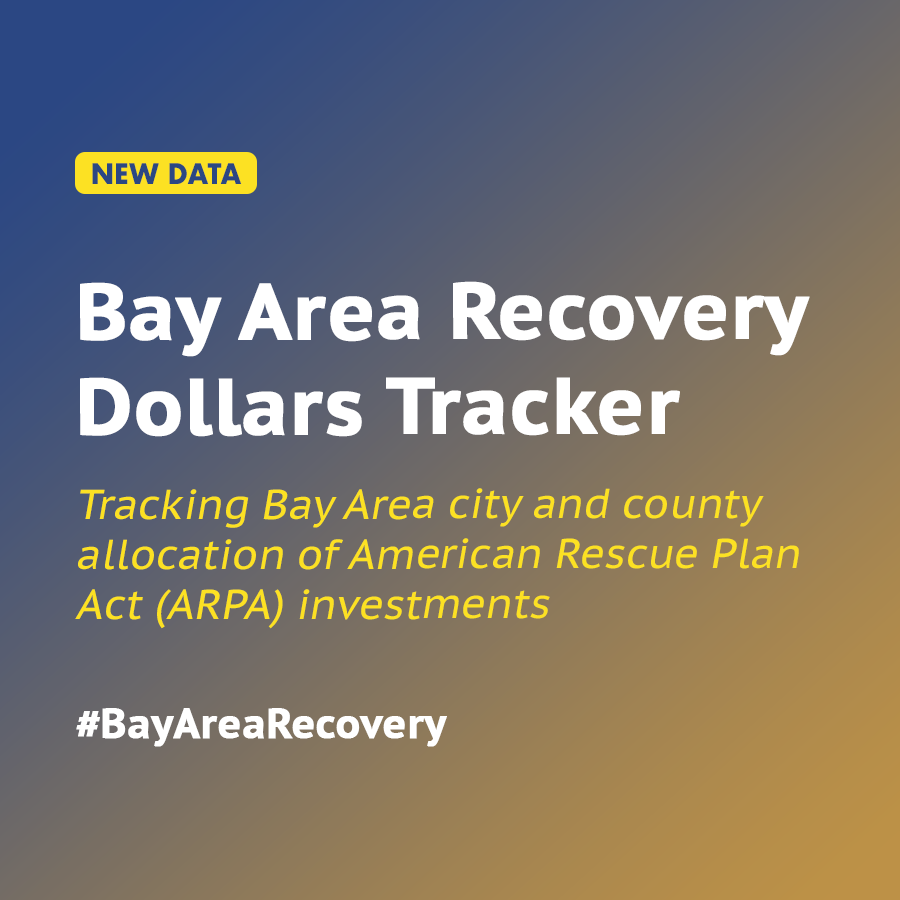Having a clear assessment of how recovery funds have been allocated is critical to ensuring local policymakers make equitable investments with what remains of these flexible resources.
OAKLAND, CA — Through the Coronavirus State and Local Fiscal Recovery Funds (SLFRF) established by the American Rescue Plan Act of 2021 (ARPA), cities and counties across the Bay Area collectively received more than $3 billion in unprecedented, flexible resources to address the immediate economic and health impacts of the pandemic and lay the foundation for a strong and equitable recovery in the region.
Today, the Bay Area Equity Atlas released a new tool — the Bay Area Recovery Dollars Tracker — that provides the fullest picture to date of how municipal governments across the nine-county region are investing their SLFRF dollars. Our analysis of the most recent public reporting data (which covers spending as of September 30, 2022) reveals that Bay Area municipal governments have made plans for how to spend $1.88 billion (68 percent) of the SLFRF funds allocated to the region, leaving more than $1 billion (38 percent) left to be allocated.
“With these recovery funds, we have a chance to invest in communities of color who were hardest hit by the pandemic,” said Fred Blackwell, CEO of the San Francisco Foundation. “This tracker increases transparency to help us keep local governments accountable as we work together to reimagine and rebuild the Bay Area.”
Other key findings include the following:
- Local governments in the Bay Area largely used SLFRF dollars to offset declines in their revenue. Nearly half (43 percent) of obligated dollars have gone to revenue replacement, which is the largest category of decided funding.
- In addition to revenue replacement, many jurisdictions made sizable investments to support communities weathering the financial and health challenges of the pandemic. This included 20 percent of obligated funding to public health projects that were responding directly to Covid, 7 percent to advance housing justice, 6 percent for cash supports, and 5 percent for projects to advance food security and bolster government infrastructure and services.
- Some Bay Area governments leveraged SLFRF funds to fund new, equity-oriented pilot programs and initiatives. Examples of these include small-scale subsidy programs to prevent families from becoming unhoused, guaranteed income pilot programs, and public health campaigns that targeted communities most impacted by the pandemic, including Black, Latinx, Native American, and Pacific Islander residents.
“Data is a vital ingredient for winning on equity — and this research ensures that actionable, data-informed insights about the use of these federal resources are directly accessible to the communities hardest hit by Covid-19,” said Michael McAfee, President and CEO of PolicyLink. “These powerful tools will support residents and advocates in holding local governments accountable for their ARPA spending decisions and pushing policymakers to make targeted investments that contribute to the well-being of everyone living in the Bay Area.”
Local governments across the Bay Area still have an opportunity to direct unallocated SLFRF funds toward ensuring lasting security and stability for the region’s communities and rectifying the systemic barriers that preceded the pandemic. As city and county leaders decide how to allocate their final SLFRF investment dollars, we urge them to consider the following recommendations:
- Invest remaining resources in programs that support the Black and brown communities who continue to experience the lingering impacts of the pandemic.
- Make targeted, permanent investments to sustain the impact of these initial investments.
- Develop equitable decision-making and transparency in spending decisions.
- Evaluate the disbursal of SLFRF funds and programmatic impacts using an equity lens.
The dashboard, analysis, and recommendations were produced in partnership with the San Francisco Foundation and an advisory group of advocacy organizations from across the region. The underlying research is based on the most recent US Treasury quarterly report on the projects and expenditures of SLFRF recipients, which includes data for all nine counties and 33 large cities in the Bay Area through September 30, 2022; performance reports submitted by large cities and counties to the US Treasury, which detail the equity considerations and community engagement processes localities used in selecting and approving SLFRF projects; and conversations with individuals running select projects funded through SLFRF dollars and members of our cross-sector committee of local advocacy organizations. To learn more about the data and methodology, visit bayareaequityatlas.org/recovery-dollars/data. Additional quotes from advocacy organizations can be found here.


